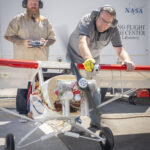The wings of many flying insects — bees, butterflies and dragonflies, for instance — seem to follow the same blueprint: A solid surface or membrane pushes against the air to keep these animals aloft. But new data show that for the tiniest fliers, there’s a better way: brushes.
The littlest insects are smaller than a grain of rice. Their wings look like tiny bristles or feather dusters, with visible air gaps throughout. It’s a clever adaptation for flying when you’re incredibly small, the new work shows.
Bristled wings are light and surprisingly stiff. They also use less effort to flap than solid wings. This makes it easier for miniature insects to flap quickly and stay airborne — important for moving through air that feels very different at their tiny scale.
And understanding how these unusual wings work could also inspire new technology.
“Currently, we have robotic insects the size of normal flying insects. But what would be nice is ultra-miniature robots, things you can’t even see,” says Mostafa Nabawy. He works at the University of Manchester in England and had no role in the new research. Bristled wings, this aerospace engineer suspects, might help make such super-mini robots possible.
Air in a tiny world
For more than a decade, Dmitry Kolomenskiy has been part of a team puzzling over why small insects evolved bristled wings. A computational scientist, he works at Skolkovo Institute of Science and Technology. That’s in Moscow, Russia.
For answers, his team gathered data on 38 species of tiny beetles. Their wings ranged in length from just 0.3 to 5 millimeters (0.01 to 0.2 inch). That’s very small — from the width of a couple hairs to about the size of a few grains of sand laid end to end. Many of the beetles came from Russia and Vietnam.
Back in the lab, the researchers used microscopes to measure the shape of each wing and count its bristles. And with high-speed cameras, they tracked how fast the beetles’ wings flapped in flight.
To their surprise, the beetles flapped at about the same speed regardless of the wings’ size. That’s unusual, Kolomenskiy says. Among birds and larger insects, smaller wings usually flap faster.
It comes down to how these wings interact with air, Kolomenskiy now concludes. To humans and other large animals, air feels light and breezy. But insects that are just a few millimeters long experience air very differently, he points out. “At these small scales, they really feel air like a very viscous media,” he explains.
“Think of maple syrup,” he says. “You get [that] kind of flow for air, if you are very small.”
Fluids, it turns out, behave differently at small scales. Viscous forces now dominate. Here, air doesn’t easily slip through small gaps the way it does at larger scales. Instead, it flows slowly and sticks to surfaces, like syrup clinging to a spoon.
As a result, tiny insects “are almost not flying in the air,” says Nabawy, the aerospace engineer. “They are actually swimming in the air.”
Because the air acts like a thick, syrupy liquid, it doesn’t flow through the gaps in a tiny wing’s bristles. Instead, it gets “stuck” and flows around the bristles.
“Visually, it looks like there’s a lot of void between [the bristles],” says Kolomenskiy. “But for the [air], it’s not transparent. The flow goes around.”
Modeling the miniature
The smaller the insect, the stickier the air can feel. So the researchers created a computer model. It analyzed what design would allow these tiny insects to flap with the least effort before their flight performance suffers.
This model looked at how stiff the bristles need to be so they won’t bend. It also tested how widely bristles can be spaced without leaking air.

Gaps between bristles increased as a wing got smaller, they found. The tiniest wings (0.3 to 0.5 millimeter) had the fewest bristles, and they were spaced farthest apart. Wings with fewer bristles weigh less. That helps these insects flap at high speeds without using much energy, Kolomenskiy observes.
Longer wings — those more than about 1.7 millimeters — evolved more bristles and ones that are more closely spaced. As those bristles get very tightly packed, they eventually start to look more like a membrane.

Lastly, the team looked at wing stiffness. Wings that bend too much as they flap don’t push hard enough against the air to generate lift. That’s the force needed to keep things aloft. The computer model showed that both the bristles and what they attach to need enough rigidity to hold the wing’s shape during each flap.
The researchers shared their discoveries Aug. 22 in the Proceedings of the National Academy of Sciences.

“Bristled wings are a clever mechanical optimization,” says Kolomenskiy. Light yet stiff, they can move through a thick, viscous air environment, getting enough lift for flight.
Engineers might borrow the same tricks to design miniature flying robots, he believes. For instance, swarms of tiny flying robots — sometimes called “robobees” — could flit through greenhouses to pollinate crops. Alternatively, squadrons of micro-drones might search collapsed buildings for survivors or monitor things in the environment.
Do you have a science question? We can help!
Submit your question here, and we might answer it an upcoming issue of Science News Explores




